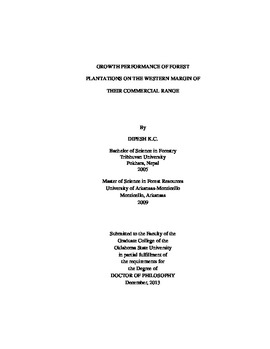| dc.contributor.advisor | Will, Rodney Edward | |
| dc.contributor.author | K. C., Dipesh | |
| dc.date.accessioned | 2015-06-17T20:06:29Z | |
| dc.date.available | 2015-06-17T20:06:29Z | |
| dc.date.issued | 2013-12 | |
| dc.identifier.uri | https://hdl.handle.net/11244/14920 | |
| dc.description.abstract | The southern US contains some of the most productive plantation sites in the USA and Oklahoma is the western margin for several plantation species including sycamore (Platanus occidentalis), eastern cottonwood (Populus deltoides), loblolly pine (Pinus taeda L.), shortleaf pine (P. echinata Mill.), and pitch X loblolly pine hybrid (P. rigida X P. taeda). The long, hot summers and dry winters of Oklahoma provide an opportunity to compare the growth performance of these species at the edge of or outside of their natural range. The region is also prone to ice storms and glaze and pine plantations are negatively affected during such disturbances. Hence we carried out comparative studies on growth performance of different plantations in Oklahoma. One examined the growth performance and nutrient (nitrogen and phosphorus) uptake by sycamore and eastern cottonwood from a decommissioned swine lagoon in the north-central Oklahoma. The results showed that eastern cottonwood outperformed sycamore in both growth and nutrient uptake. The species showed the potential for removing a substantial amount of nutrients from the soil. In another comparative study between loblolly pine, shortleaf pine and pitch X loblolly pine hybrid in southeastern Oklahoma, loblolly pine outperformed both the other species, although shortleaf pine was native to the area. However, wood specific gravity was similar among the species. The final study examined simulated ice damage on loblolly pine stands which had previously undergone either thinning or thinning and pruning. Damaged trees had an average 2.4 m of the top removed. Four years after damage, the relative basal area decreased as the amount of live crown ratio loss increased. Thinned stands showed lower relative reduction in growth with the same level of crown damage than the non-thinned stands. Undamaged trees did not benefit from the opening caused by damaged trees. Unless the damage is severe, the stand can be allowed to recover after the thinning of the damaged trees. | |
| dc.format | application/pdf | |
| dc.language | en_US | |
| dc.rights | Copyright is held by the author who has granted the Oklahoma State University Library the non-exclusive right to share this material in its institutional repository. Contact Digital Library Services at lib-dls@okstate.edu or 405-744-9161 for the permission policy on the use, reproduction or distribution of this material. | |
| dc.title | Growth performance of forest plantations on the western margin of their commercial range | |
| dc.contributor.committeeMember | Hennessey, Thomas C. | |
| dc.contributor.committeeMember | Lynch, Thomas B. | |
| dc.contributor.committeeMember | Penn, Chad J. | |
| osu.filename | KC_okstate_0664D_13087.pdf | |
| osu.accesstype | Open Access | |
| dc.type.genre | Dissertation | |
| dc.type.material | Text | |
| thesis.degree.discipline | Forest Resources | |
| thesis.degree.grantor | Oklahoma State University | |
